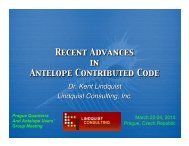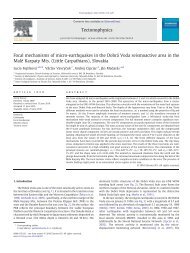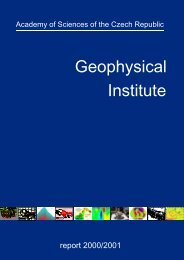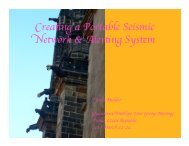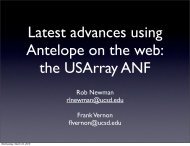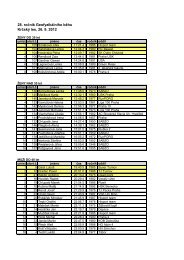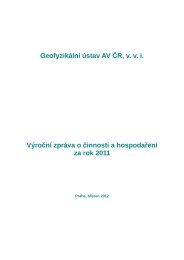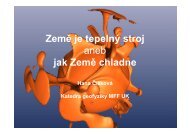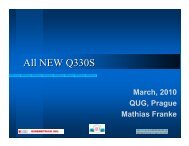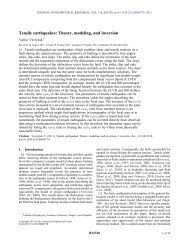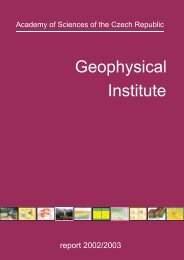Geophysical Institute of the ASCR
Geophysical Institute of the ASCR
Geophysical Institute of the ASCR
Create successful ePaper yourself
Turn your PDF publications into a flip-book with our unique Google optimized e-Paper software.
Research into stochastic methods for <strong>the</strong> magnetotelluric interpretation has been newly extended to<br />
deal with problems <strong>of</strong> <strong>the</strong> MT tensor decomposition. Magnetotelluric directional analysis and<br />
impedance tensor decomposition are basic tools that are employed standardly to validate<br />
a local/regional composite electrical model <strong>of</strong> <strong>the</strong> underlying structure, as well as to extract<br />
quantitative information about both <strong>the</strong> regional conductor, <strong>of</strong>ten with a specific type <strong>of</strong> symmetry,<br />
and <strong>the</strong> local distorters. As <strong>the</strong> effect <strong>of</strong> local galvanic distortions can result in considerably blurring<br />
<strong>the</strong> image <strong>of</strong> <strong>the</strong> deeper regional conductor, reliable quantitative estimates <strong>of</strong> both <strong>the</strong> decomposition<br />
parameters and <strong>the</strong>ir uncertainties are needed. Bayesian stochastic methods are particularly suitable<br />
for this purpose, as <strong>the</strong>y handle <strong>the</strong> uncertainties <strong>of</strong> <strong>the</strong> estimated parameters in a parametric fashion<br />
through <strong>the</strong> use <strong>of</strong> posterior model probabilities. We formulated <strong>the</strong> baysesian approach to <strong>the</strong> MT<br />
decomposition problem within <strong>the</strong> standard Groom-Bailey decomposition scheme. Construction <strong>of</strong><br />
<strong>the</strong> likelihood function was based on <strong>the</strong> assumption <strong>of</strong> <strong>the</strong> experimental impedance estimates being<br />
contamined with Gaussian noise. For <strong>the</strong> decomposition parameters, we used non-informative, flat<br />
priors within finite, physically justified intervals. Fur<strong>the</strong>r, we applied a simple Markov chain Monte<br />
Carlo technique with a Gibbs sampler to simulate samples from <strong>the</strong> posterior distribution <strong>of</strong> <strong>the</strong><br />
composite models conditioned on <strong>the</strong> experimental data, and characterize <strong>the</strong> estimates and<br />
uncertainties <strong>of</strong> <strong>the</strong> decomposition parameters by using <strong>the</strong> respective marginal posterior probabilities<br />
(an example shown in Fig. 35). The technique has proved reliable and stable for a wide range <strong>of</strong> MT<br />
decomposition problems, including those with multiple frequency and multiple site data sets, as well<br />
as those with static magnetic distortions considered.<br />
References<br />
Semenov V.Yu., Jozwiak W. and Pek J., 2003. Deep electromagnetic soundings conducted in Trans-European Suture Zone.<br />
EOS Trans. AGU, 84, No. 52, 581-584.<br />
Kováčiková S., Červ V., Praus O., 2005. Modelling <strong>of</strong> <strong>the</strong> conductance distribution at <strong>the</strong> eastern margin <strong>of</strong> <strong>the</strong> European<br />
Hercynides. Stud. Geophys. Geod., 49, 403-421.<br />
Li Y., Pek J. and Brasse H., 2005. Magnetotelluric inversion for 2D anisotropic conductivity structures. In Proc. 20th Colloq.<br />
‘Electromagnetic Depth Investigations’, Hoerdt, A. and Stoll, J. (Eds.), DGG, 250-259.<br />
Pek J., Santos F.A.M., and Li, Y., 2005. Parametric sensitivities for 2-D anisotropic magnetotelluric models. In Proc. 20th<br />
Colloq. ‘Electromagnetic Depth Investigations’, Hoerdt, A. and Stoll, J. (Eds.), DGG, 240-249.<br />
Numerical simulations <strong>of</strong> <strong>the</strong> hydromagnetic dynamos.<br />
The <strong>the</strong>ory <strong>of</strong> <strong>the</strong> hydromagnetic dynamo seems to be <strong>the</strong> best explanation <strong>of</strong> <strong>the</strong> generation<br />
mechanism <strong>of</strong> <strong>the</strong> magnetic fields and <strong>the</strong>ir temporal and spatial evolution. Due to <strong>the</strong> complexity and<br />
non-linearity <strong>of</strong> <strong>the</strong> hydromagnetic dynamo problems, which includes a system <strong>of</strong> 3D partial<br />
differential equations for <strong>the</strong> magnetic field, momentum equation for velocity, as well as <strong>the</strong> heat-flux<br />
equation, numerical simulations are usually used. The results <strong>of</strong> numerical geodynamo simulations<br />
performed in <strong>the</strong> last decade, based on spectral methods are in a very good agreement with<br />
observations and paleomagnetic studies even though <strong>the</strong>y have been done for <strong>the</strong> parameters, which<br />
are far-away from <strong>the</strong> Earthlike ones, e.g. Ekman number, as a measure <strong>of</strong> viscous forces, is extremely<br />
high. It is expected that higher spatial resolution and, consequently, lower values <strong>of</strong> Ekman number<br />
could be better achieved by grid methods. We have focused our attention on finite (control) volumes<br />
method, which supports <strong>the</strong> stability <strong>of</strong> <strong>the</strong> solutions near <strong>the</strong> axis <strong>of</strong> rotation. This method is efficient<br />
on a parallel computer because only "nearest neighbor" communication between <strong>the</strong> processors would<br />
be needed – instead <strong>of</strong> <strong>the</strong> global communication needed for spherical harmonic codes. Therefore,<br />
when much higher spatial resolution is desired to simulate geodynamo action, this method may be<br />
a better choice than a spherical harmonic method.<br />
The hydrodynamic part <strong>of</strong> <strong>the</strong> problem – <strong>the</strong>rmal convection in a rotating spherical shell - was tested<br />
by means <strong>of</strong> "numerical dynamo benchmark" and <strong>the</strong> results were in a good agreement with <strong>the</strong><br />
51



